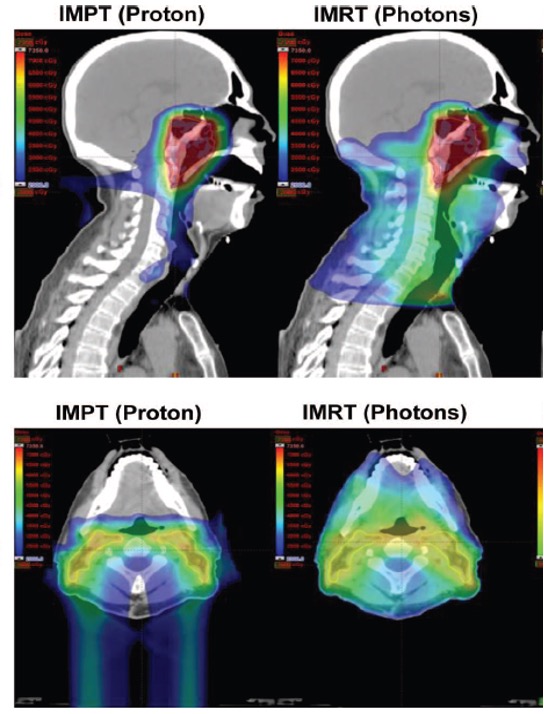Current evidence on proton therapy for head and neck squamous cell carcinoma
By Christina L. Mershell
Share:

Cancer specialists who treat cancer of the head and neck have come together to review the current evidence on the use of proton therapy treatment for patients with head and neck squamous cell carcinoma (HNSCC). “Squamous cell carcinoma of the head and neck occurs in the outermost surface of the skin or certain tissues within the head and neck region including the throat, mouth, sinuses and nose. Squamous cell carcinoma makes up about 90% of all head and neck cancers.”1
One collaboration to review the current evidence on the use of proton therapy for head and neck squamous cell carcinoma was published in Cancers, a peer-reviewed medical journal and is titled “Proton Therapy for Squamous Cell Carcinoma of the Head and Neck: Early Clinical Experience and Current Challenges.”2 Led by researchers in Belgium, oncology experts from the United States, Australia, Slovenia, Italy and China contributed their experience.
So What was the Consensus on the Use of Proton Therapy for Head and Neck Squamous Cell Carcinoma?
Proton therapy, an advanced form of radiation treatment designed to combat cancer cells by targeting them more precisely, and its application in head and neck cancer is becoming more widely accepted. Unlike conventional photon-based treatments, proton therapy utilizes the ability of protons to stop at a designated depth in the body, minimizing radiation exposure to surrounding healthy tissues and can be used for many types of cancer.
This targeted approach has the potential to reduce toxicity, a significant concern in squamous cell cancer treatment of the head and neck region. Avoiding radiation to the jawbone, salivary glands, eyes and spinal cord are critical in reducing treatment related side effects such as dry mouth and swallowing difficulty, as well as improving overall treatment success.
The calculation of the radiation dose deposited to different parts of the head and neck when treating people with proton therapy can be seen in the dosimetry treatment plans. Below is an example of how much less of a patient’s mouth may receive radiation dose with proton therapy (IMPT) vs. conventional photon/X-ray radiation (IMRT).

What Research is Still Needed?
While some positive outcomes from the use of proton therapy alone for head and neck squamous cell carcinoma are reported, these are based on small studies. The article, referenced above, encourages further exploration of this approach in larger numbers of patients and stresses the need for investigations that specifically evaluate toxicity (side effects) and cancer cure rates.
The authors stress the need for well-designed prospective studies (enrolls patients before or during treatment and follows them over a long period of time) comparing the effectiveness and benefits of proton therapy to traditional photon radiation or intensity-modulated radiation therapy (IMRT). Addressing long-term toxicity concerns (side effects) and optimizing treatment plans to account for anatomical changes between treatment sessions are highlighted as crucial challenges.
The review also emphasizes the importance of collaboration between radiation oncologists, health economists, patient advocates and governments to evaluate reimbursement strategies for head and neck squamous cell carcinoma patients undergoing proton therapy. The article suggests that a model-based patient selection process, continually validated, represents the most evidence-based approach for achieving maximal cost-effectiveness.
In summary, proton therapy presents a promising avenue for treating head and neck squamous cell carcinoma, potentially offering reduced toxicity and improved outcomes. However, the article highlights the importance of comprehensive studies, collaboration across various stakeholders, and addressing challenges in treatment planning and reimbursement evaluation to fully realize the benefits of proton therapy for head and neck squamous cell carcinoma patients.
More Research
In response to this review of early experiences treating head and neck squamous cell carcinoma with proton therapy, Chia-Lun Chang et al published the results of their study in 2023 comparing outcomes between proton and X-ray radiation treatments (IMRT).3 With 982 patient outcomes compared, proton therapy proved to have better outcomes than IMRT. Patients with head and neck squamous cell carcinoma had higher overall survival rates and fewer instances of cancer recurrence in the head and neck area. This additional data is valuable as radiation oncologists assess treatment options for people newly diagnosed with squamous cell carcinoma in the head and neck region.
Steven J. Frank, M.D., professor of radiation oncology at the MD Anderson Proton Therapy Center, has conducted extensive research in collaboration with other experts on the use of proton therapy for head and neck cancers. While it is often difficult to enroll enough patients in randomized trials involving proton therapy, he has recently completed enrolling patients in a randomized trial looking at the effectiveness of proton therapy versus traditional X-ray radiation (photon/IMRT).5 This continuous research is critical to the future of cancer care.
Reviewing More of the Latest Research
Another great review of more than 50 publications on the use of “Proton Beam Radiation Therapy for Oropharyngeal Squamous Cell Carcinoma” 4 was published in the International Journal of Particle Therapy (IJPT) in 2023. This article also discussed the importance of continued research. Due to the limited availability of proton centers in the United States and the increased cost of treatment, it is beneficial to create models to determine who can benefit the most from proton therapy.
Who benefits the most?
Compiled research showed that “the benefit, if any, is most pronounced in younger patients with earlier-stage disease who have a good prognosis and longer life expectancy.4
Survival outcomes
Data from five proton centers showed disease-free survival rates ranging from 65% to 96% ranging from 1-5 years following proton therapy treatment. See table 2 in this article for more details.
Reduced side effects
Multiple studies demonstrated less dry mouth (xerostomia) and mouth soreness (mucositis), fewer changes in taste and appetite, reductions in the number of patients needing a feeding tube, fewer hospitalizations within 60 days of treatment and less instances of bone damage. These outcomes allows patients to continue to eat enough food and drink to stay nourished throughout treatment. Two studies also showed a reduction in the instance of another type of cancer following radiation treatment.
Reducing radiation dose
Because proton therapy can provide a more targeted treatment option for many people with head and neck squamous cell carcinoma, there is the potential for deintensifying treatment. This refers to the ability to give less radiation in certain cases. This article looked at studies showing the ability to still have high survival rates and fewer side effects with less radiation for people who are HPV 16–positive and do not have a strong history of smoking.
Reviewed March 25, 2024, by William M. Mendenhall, MD, FACR
Click here to discover more about the benefits of proton therapy for the treatment of head and neck cancers.
2 Proton Therapy for Squamous Cell Carcinoma of the Head and Neck: Early Clinical Experience and Current Challenges, https://www.ncbi.nlm.nih.gov/pmc/articles/PMC9179360/
3 Comparing the oncologic outcomes of proton therapy and intensity-modulated radiation therapy for head and neck squamous cell carcinoma, https://www.sciencedirect.com/science/article/abs/pii/S0167814023898656
4 Proton Beam Radiation Therapy for Oropharyngeal Squamous Cell Carcinoma, https://meridian.allenpress.com/theijpt/article/9/4/243/492861/Proton-Beam-Radiation-Therapy-for-Oropharyngeal?searchresult=1



